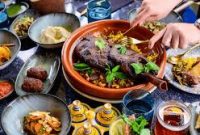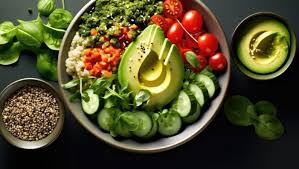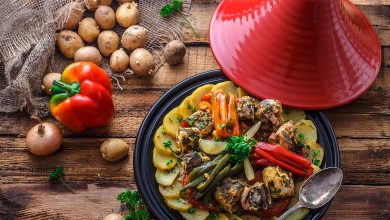What is the national cuisine of Morocco? What is the origin of Moroccan cuisine?
the national cuisine of Morocco
What is the national cuisine of Morocco?
It’s common to refer to Morocco’s national food as “Moroccan cuisine.” Its vast and varied culinary heritage is a reflection of the topography, history, and cultural influences of the nation. Among the most well-known and emblematic Moroccan dishes are the following:
Tagine: A tagine is a classic clay or ceramic pot with a conical lid used to cook stews slowly. It may contain a range of ingredients, including as veggies, dried fruits, and a blend of spices, along with soft meats like lamb, chicken, or beef. The slow cooking method allows the flavors to meld together, resulting in a flavorful and aromatic dish.
Couscous: CA mainstay of Moroccan cooking, ouscous is frequently used as a foundation for other stews and meals. Made with crushed and cooked wheat semolina, it’s typically served with meat, veggies, and a tasty sauce.
Harira: During the holy month of Ramadan, people frequently consume the substantial soup known as harira. Tomatoes, lentils, chickpeas, and a mixture of flavorful spices are used to make it. To break the fast, harira is usually served with dates and chebakia, which are pastries drenched in honey.
Moroccan Mint Tea: Green tea leaves, fresh mint, and a lot of sugar are combined to make the beloved and emblematic Moroccan mint tea. It is a symbol of welcome in Moroccan culture and is renowned for its sweet and refreshing flavor.
Pastries and Sweets: Moroccan pastries are renowned for their confections that are sweet and nut-filled. The particularly popular Baklava is constructed with layers of dough, honey, and almonds. Other well-liked pastries are chebakia, ghriba, and ma’amoul.
Seafood: Morocco has a long coastline, hence seafood plays a significant role in the country’s cuisine. Particularly in coastal areas, grilled sardines, fish tagines, and seafood couscous are popular meals.
Preserved Lemons: Lemons that have been preserved are frequently used in Moroccan cuisine. Lemons are preserved in a brine of salt and lemon juice, which gives them a zesty, fragrant flavor that may be added to a variety of foods.
Moroccan cooking is renowned for its use of a variety of ingredients, its use of fragrant spices, and its blending of savory and sweet flavors. Its rich and varied culinary culture is appreciated in Morocco and across the world. It is a synthesis of French, Andalusian, Arab, and Berber influences.
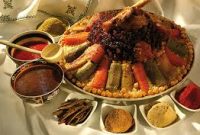
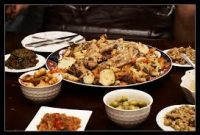
What is the origin of Moroccan cuisine?
Moroccan food has a long and varied culinary history that is influenced by many different places and civilizations. Its roots are found in the fusion of native French, Arabic, Andalusian, and Berber culinary traditions. An outline of the history of Moroccan food is provided below:
Berber Influence: There is a lengthy history of culinary traditions among the native Berber people of North Africa. Numerous essential components of Moroccan cooking, such grains, preserved lemons, and couscous, have their roots in Berber culinary traditions. Berber cooking methods have also affected tagines, which cook food slowly.
Arab Influence: Arab culinary methods, the liberal use of spices, and dried fruits were all introduced to the region with the Arab conquest of North Africa. Moroccan cuisine’s taste characteristics are mostly influenced by Arab culinary traditions.
Andalusian Influence: The Andalusian Moors, who were driven from Spain during the Middle Ages, made Morocco their home. The culinary customs of Al-Andalus, or medieval Muslim Spain, were carried by them. The usage of components like almonds and saffron, as well as the merging of savory and sweet flavors, are examples of this influence in Moroccan cooking.
French Influence: From 1912 to 1956, Morocco was a protectorate of France. During this time, French cooking methods and ingredients were brought to Morocco and incorporated into the cuisine. French influence may be seen in Moroccan cooking’s use of butter, baguettes, and pastries.
Geographical Factors: Morocco’s cuisine has been greatly influenced by its varied topography, which includes long beaches, dry deserts, and lush plains. Moroccan cuisine is diverse due in part to the abundance of a broad range of ingredients, such as cereals, fruits, vegetables, animals, and seafood.
Trade and Cultural Exchange: For ages, Morocco has served as a center for commerce and cultural interaction due to its advantageous location at the intersection of Africa, Europe, and the Middle East. As a result, Moroccan food now includes tastes and ingredients from other countries.
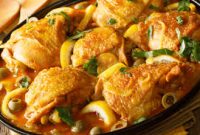

These geographical, historical, and cultural elements have combined to create the distinctive and varied tastes and ingredients that define Moroccan cuisine. It is a cuisine renowned for the use of a variety of fresh ingredients, the blending of sweet and savory flavors, and its fragrant spices.
